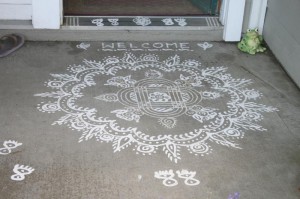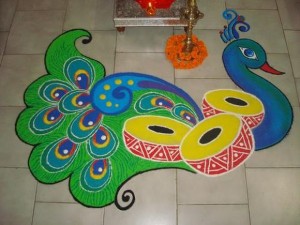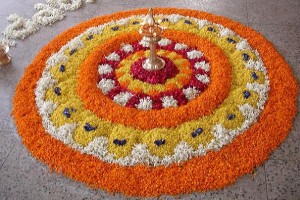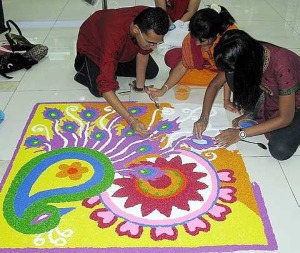Kolam and Rangoli
The Kolam, which is also known as the Rangoli or Muggu, is a type of Indian folk art. They are usually made during Deepavali or any other festival. The name itself when translated means “row of colors”. They are bright decorative designs made at the entrance of a home and can be made from a variety of materials including rice flour, colored rice, colored sand or even flower petals. The patterns range from the simpliest geometrical designs to the most elaborate deity shapes and impressions.
The Significance
There are a few beliefs tied to the Kolam. One belief is that there is both negative and positive energy in the air. The web-like design and the complexity of the Kolam traps the negativity in the air, thus stopping it from entering the home. During Deepavali, it is made as a visual form of prayer to the Goddess Letchumi to welcome her into the home and ask her for blessings. Some also believe that the Kolam stops evil from entering the home. Although the Deepavali festival lasts 5 days, some keep the Kolam designs drawn for 10 days.
The Key Elements
The images depicted in the Kolam can be anything from abstract geometrical shapes to landscapes. They can also be depictions of flora and fauna. Some common symbols and images used in the Kolam are the lotus flower and its’ leaves, the mango fruit, fish, and different kinds of birds like parrots, swans and peacocks. Kolams can also feature human figures and foliage.
The Stories Behind the Kolam
The legends of how the first Kolam came to be are ancient. One popular legend tells of the devestation of a king when the son of his high priest died. The king goes to Lord Brahma and asks him for help. Lord Brahma tells the king to draw the image of the boy onto a wall so that he could breathe life into it.
Another legend tells of a god that once used the juices of a mango to paint the figure of a woman. Apparently, the painting was so beautiful that it made all the heavenly maidens jealous of it.
In Tamil Nadu there is a prevalent myth of Andaal. Andaal was a woman who defied the expected path of women in her culture and didn’t marry. She worshipped the God Thirumal and eventually ended up marrying him. In honor of Andaal, unmarried women now get up before dawn to make the Kolam to welcome Thirumal. In fact, although now created by both men and women, the Kolam is traditionally considered to be a woman’s art.




